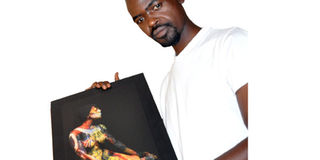Using art to depict reality

What you need to know:
As an art manager, Kalungi guides artists regarding what kind of work they need to produce and package that art for presentation to the right client locally or internationally.
Daudi Karungi is primarily an artist, a gallery owner, a curator, a businessman and most of all, a keen student of life. His latest piece is called Fort Jesus, a mixed media of photography and acrylics paint.
“I am an inventive artist, meaning the one who creates where there is nothing. I use this even in the choices of business I invest in,” he says.
His journey as an artist started at Makerere University at the Margaret Trowell School of Fine Art during his final year, in 2001.
In November the same year, he started Afriart Gallery in Kamwokya, off old Kira Road. He wanted to provide space where artists would sell their work.
On realising he wanted to be an artist, he embarked on a journey that took him two years to make a series of paintings that he could exhibit.
His first solo exhibition was also one of the first he held at Afriart Gallery. Karungi considers this gallery one of his most impressive artworks because he started it with no knowledge of art management but it is now a source of art management knowledge.
Although an artist by schooling, he doubts that he ever picked inspiration from school. He insinuates that art must have been fed to him growing up.
From experience, he also believes that good artists are born and they train to be better, after all he says, “Practice makes perfect.”
Teaching people about art
To make art more appealing to Ugandans, Afriart Gallery has this year embarked on educating Ugandans about the value of Art. “We are helping organise the first Kampala Art Biennale, a big art exhibition showcasing art from Uganda and other African countries and it will be in Kampala this August. During the exhibition, there will be art talks to CEO’s, MP’s and university students,” Karungi says.
It has taken a lot of patience for artists like Karungi to survive particularly in Uganda where locals are not as keen to this art form as they are to music. Even then, the 34-year-old artist argues that art is the most important profession in the world, and has been for centuries.
“Rome was built by artists, so I think Uganda is getting misguided by dropping art from government sponsorship. Art should be accepted in Uganda. It is the only constant thing in society,” he argues. According to him, artists can earn from their trade if they manage their earnings better.
“Most artists treat money like fishermen. They do not invest in other stable ventures because they know they will sell another painting. I started my wine import business from art, bought my first car, land and travelled the world all from art,” he says proudly.
His contributions to art
Karungi’s gallery has given birth to many artists who are best sellers today and it has elevated art to society. And he is not done dreaming. Besides the Kampala Art Biennale, he also envisions setting up the first museum of modern art.
Karungi wakes up at 6:45am, drinks two cups of freshly ground coffee and thereon a glass of freshly-extracted juice made from beetroot.
He will then head into busy Kampala for work. This goes on till about 8pm when he returns home.
But it is not work, work and more work everyday. “I like to have fun and there is no limit to what kind of fun I can have. My friends always call me the last man standing when we have parties. I guess I work hard and play hard,” he concludes.
ABOUT ART
Karungi argues that art should be used to represent the reality in situations. For instance, he argues that Africans are masters at the art of façade.
“We change our outfits and our accents to suit the occasion. We attach strings of titles to our names to make sure people know who we are. My work is about the tension between these personas and the reality that lies beneath them,” he explains.
So in a way, his work is an exploration of contradiction, of the countless paradoxes that are ever visible in our everyday lives: tradition and modernity; generosity and greed; vitality and death.
As an art manager, Kalungi guides artists regarding what kind of work they need to produce and package that art for presentation to the right client locally or internationally.
Karungi believes our efforts make our destiny. “So the need to reach the top of whatever I do inspires me to keep growing. I believe my life and work is one big masterpiece that I am working on,” he says.
KARUNGI'S STYLE
His paintings and woodcuts are of familiar images of people, objects and animals, but his style is conceptual rather than realistic. It follows the tradition of indigenous expressionism, pioneered by Ugandan artists, which draws on ancestral heritage, childhood memory and the subconscious.
In his works, he uses a multitude of media and materials like new textures and patterns, with everything from textiles to glitter. With these he can create contrast. “My goal is an effect that is at once startling and smooth, mysterious and generous,” he adds.
CAREER HIGHS
2008: Had an exhibition in New York that sold out to mostly people working at Rockefeller Foundation, at Susan Elly Gallery, New York.
Writing books: He has published two books, Extraordinary- Significant women of Uganda and another one titled All Colour No Cool.
November, 5, 2013: He was one of Ugandan artists featured in the first East African Auction of Modern and Contemporary Art in Nairobi.




